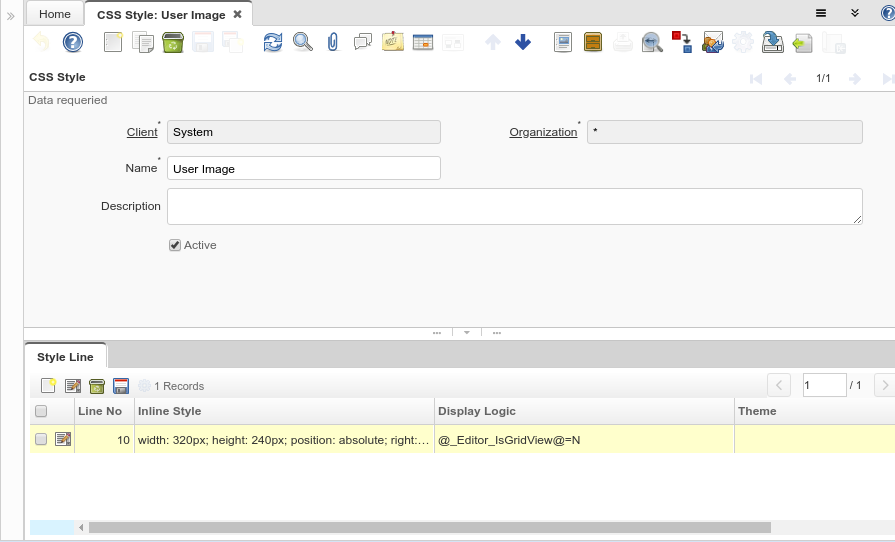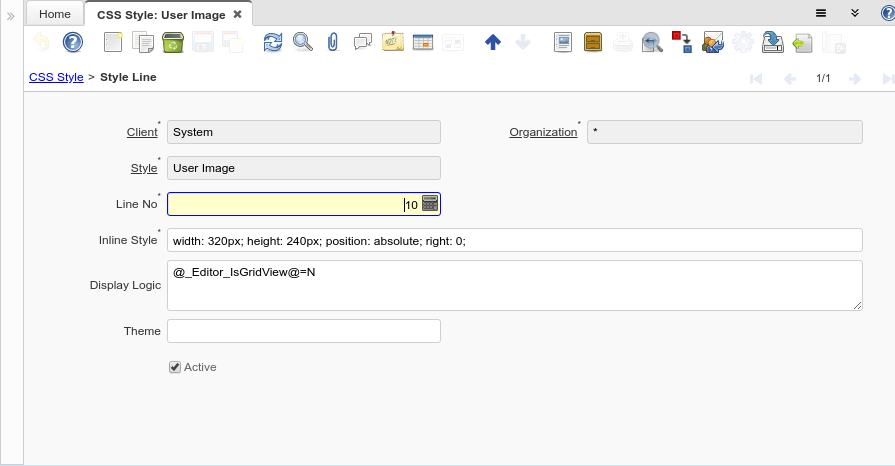CSS Style (Window ID-200086)
Window: CSS Style
Description:
Help:
Tab: CSS Style
Description: CSS Inline Style Definitions
Help:
| Name | Description | Help | Technical Data |
|---|---|---|---|
| Tenant | Tenant for this installation. | A Tenant is a company or a legal entity. You cannot share data between Tenants. | AD_Style.AD_Client_ID numeric(10) Table Direct |
| Organization | Organizational entity within tenant | An organization is a unit of your tenant or legal entity - examples are store, department. You can share data between organizations. | AD_Style.AD_Org_ID numeric(10) Table Direct |
| Name | Alphanumeric identifier of the entity | The name of an entity (record) is used as an default search option in addition to the search key. The name is up to 60 characters in length. | AD_Style.Name character varying(60) String |
| Entity Type | Dictionary Entity Type; Determines ownership and synchronization | The Entity Types "Dictionary", "iDempiere" and "Application" might be automatically synchronized and customizations deleted or overwritten.
For customizations, copy the entity and select "User"! |
AD_Style.EntityType character varying(40) Table |
| Description | Optional short description of the record | A description is limited to 255 characters. | AD_Style.Description character varying(255) String |
| Wrap With Span | Wrap content in Span and apply the Style to it. | AD_Style.IsWrapWithSpan character(1) Yes-No | |
| Active | The record is active in the system | There are two methods of making records unavailable in the system: One is to delete the record, the other is to de-activate the record. A de-activated record is not available for selection, but available for reports.
There are two reasons for de-activating and not deleting records: (1) The system requires the record for audit purposes. (2) The record is referenced by other records. E.g., you cannot delete a Business Partner, if there are invoices for this partner record existing. You de-activate the Business Partner and prevent that this record is used for future entries. |
AD_Style.IsActive character(1) Yes-No |
Tab: Style Line
Description: CSS Style Lines
Help:
| Name | Description | Help | Technical Data |
|---|---|---|---|
| Tenant | Tenant for this installation. | A Tenant is a company or a legal entity. You cannot share data between Tenants. | AD_StyleLine.AD_Client_ID numeric(10) Table Direct |
| Organization | Organizational entity within tenant | An organization is a unit of your tenant or legal entity - examples are store, department. You can share data between organizations. | AD_StyleLine.AD_Org_ID numeric(10) Table Direct |
| Style | CSS style for field and label | AD_StyleLine.AD_Style_ID numeric(10) Table Direct | |
| Line No | Unique line for this document | Indicates the unique line for a document. It will also control the display order of the lines within a document. | AD_StyleLine.Line numeric(10) Integer |
| Entity Type | Dictionary Entity Type; Determines ownership and synchronization | The Entity Types "Dictionary", "iDempiere" and "Application" might be automatically synchronized and customizations deleted or overwritten.
For customizations, copy the entity and select "User"! |
AD_StyleLine.EntityType character varying(40) Table |
| Inline Style | CSS Inline Style | AD_StyleLine.InlineStyle character varying(2000) String | |
| Display Logic | If the Field is displayed, the result determines if the field is actually displayed | format := {expression} [{logic} {expression}] expression := @{context}@{operand}{value} or @{context}@{operand}{value}
Strings may be in single quotes (optional) |
AD_StyleLine.DisplayLogic character varying(2000) Text |
| Theme | Theme name | AD_StyleLine.Theme character varying(60) String | |
| Active | The record is active in the system | There are two methods of making records unavailable in the system: One is to delete the record, the other is to de-activate the record. A de-activated record is not available for selection, but available for reports.
There are two reasons for de-activating and not deleting records: (1) The system requires the record for audit purposes. (2) The record is referenced by other records. E.g., you cannot delete a Business Partner, if there are invoices for this partner record existing. You de-activate the Business Partner and prevent that this record is used for future entries. |
AD_StyleLine.IsActive character(1) Yes-No |


